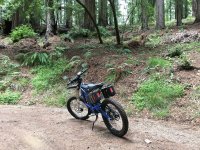You are using an out of date browser. It may not display this or other websites correctly.
You should upgrade or use an alternative browser.
You should upgrade or use an alternative browser.
Sur-Ron - New Mid drive Bike
- Thread starter Allex
- Start date
On-road is a lot of fun if you don't have to deal with heavy city traffic. I love riding on the few streets that are like the ones on your trail.
However, Off-road riding is really tough on the body, if you really ride fast off-road you have to be in great shape. It jolts every part of your body, if you have a bad back or neck you can forget about anything hard as you get jolted so hard. It is also very exhausting, I'm in great shape but it takes me a month of off-road riding when first starting up after the winter, for my body to adapt to it and not feel weak afterwards. Its like doing 500 body squats when you go for a ride.
However, Off-road riding is really tough on the body, if you really ride fast off-road you have to be in great shape. It jolts every part of your body, if you have a bad back or neck you can forget about anything hard as you get jolted so hard. It is also very exhausting, I'm in great shape but it takes me a month of off-road riding when first starting up after the winter, for my body to adapt to it and not feel weak afterwards. Its like doing 500 body squats when you go for a ride.
I ride off-road every weekend,it does beat you up a bit but builds muscle.I changed my rear shock to a Fox DHX2 which helped the backend to behave( less pain,better traction)Also have a set of Fox 40 forks on the way( Rst Killah fork killahs my back).Its a lot of fun passing gas bikes on the trail!
Yea,went with the 27.5 but don’t plan on going with a 21 inch front .For my weight 165lbs the stock spring with 30% sag(1inch) was in the ball park so will try it for awhile.It stays in the upper range of travel and haven’t bottomed out yet.Small bump performance is excellent .Hope to have the forks installed before next ride.
I would have bought the Dvo Jade coil shock but out of stock everywhere.Stock shock is a 10.5x3.5,you could put a 9.5 x3.5 if you skip the progressive rate linkage and attach shock direct to swing arm,then use a progressive rate spring.
I would have bought the Dvo Jade coil shock but out of stock everywhere.Stock shock is a 10.5x3.5,you could put a 9.5 x3.5 if you skip the progressive rate linkage and attach shock direct to swing arm,then use a progressive rate spring.
Rix
100 TW
Offroader said:On-road is a lot of fun if you don't have to deal with heavy city traffic. I love riding on the few streets that are like the ones on your trail.
However, Off-road riding is really tough on the body, if you really ride fast off-road you have to be in great shape. It jolts every part of your body, if you have a bad back or neck you can forget about anything hard as you get jolted so hard. It is also very exhausting, I'm in great shape but it takes me a month of off-road riding when first starting up after the winter, for my body to adapt to it and not feel weak afterwards. Its like doing 500 body squats when you go for a ride.
Yah, I take it easy riding offroad, and Im still sore just a little bit. I lift weights all year around so its not a huge adjustment after winter. But still, I get sore, like in the abs and traps after I have been off the bike for a few winter months.
Finally got some time to do some work on my bike.
I'm finally installing a new KTY 84 temp probe in my motor as I'm a bit paranoid about the temps, especially using my nuclear controller and hot 100F summer temps. I will also install my DC/DC converter for my LED lights.
This is a bitch of a job let me tell you, installing a temp sensor in a motor is probably the worst of the jobs you can do on a bike.
I'm crossing my fingers that this thing works when I put everything back .
.
Some pics:
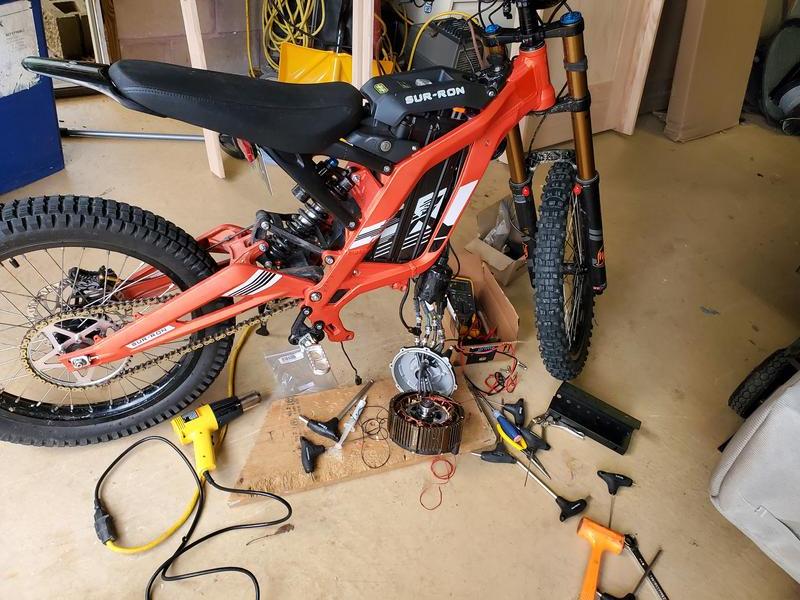
Getting these connectors off the bike was a real bitch, you can't get a wrench around them so you have to take your time. Then you have to deal with annoying rubber and plastic inserts. Words can't describe how annoying this was and then I have to put all of this back.

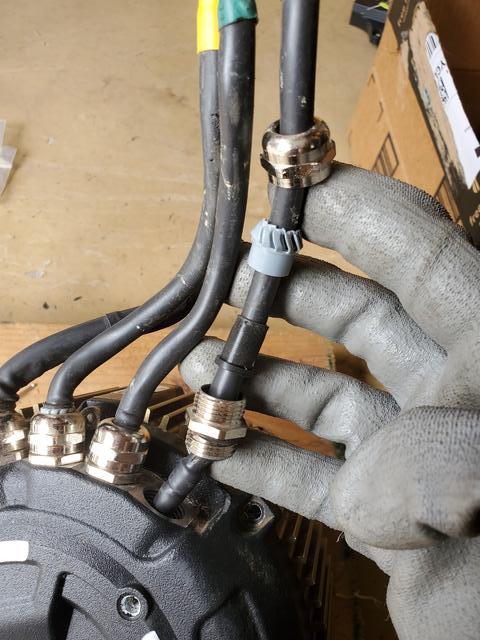
These gray plastic insert did not just lift up, you have to pry each of those plastic pieces up then lift it up.
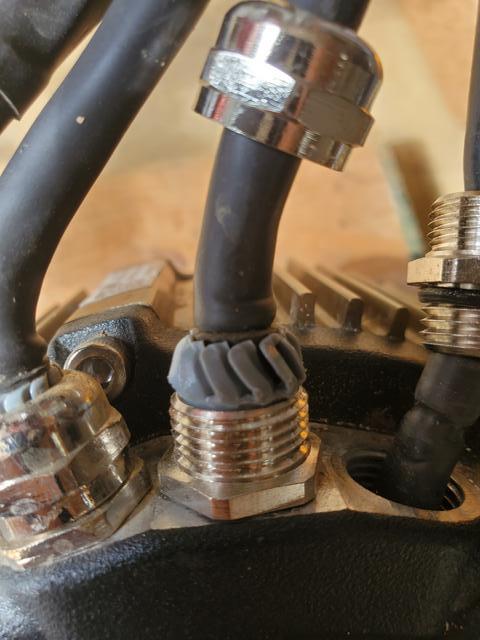
I circled in black where the old temp sensor wires connected to, the original KTY84 temp sensor broke in half at the sensor itself and pulled right out of here, I had to cut the other wire. There is no getting to this area to put the temp sensor back. Just my crap luck that my sensor broke. There is no way to know how common an issue this is because unless you get another controller you will not know if your temp sensor works. I may be the only motor which had the sensor break with my luck
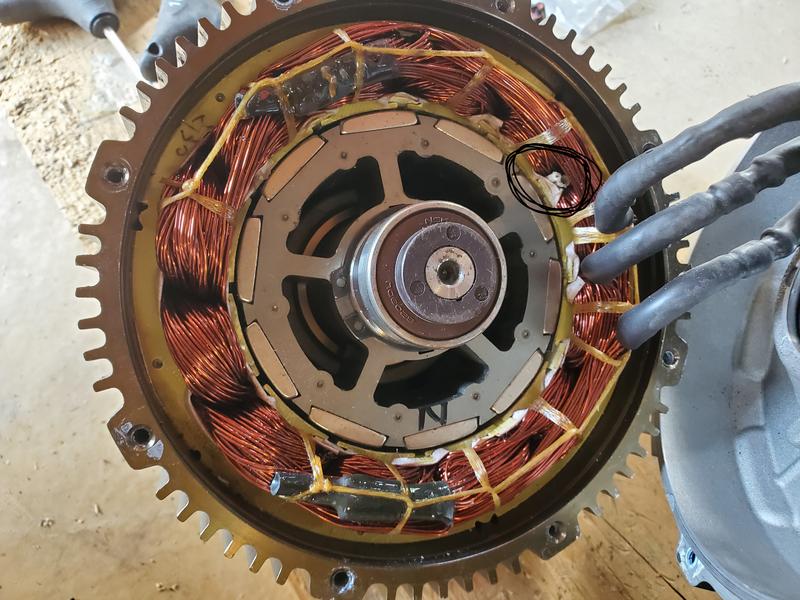
The black wire has part of the original KTY84 sensor still attached where it broke off. You can see the halls gray wire just behind it connected to what looks like a circuit board in the center of the case cover.
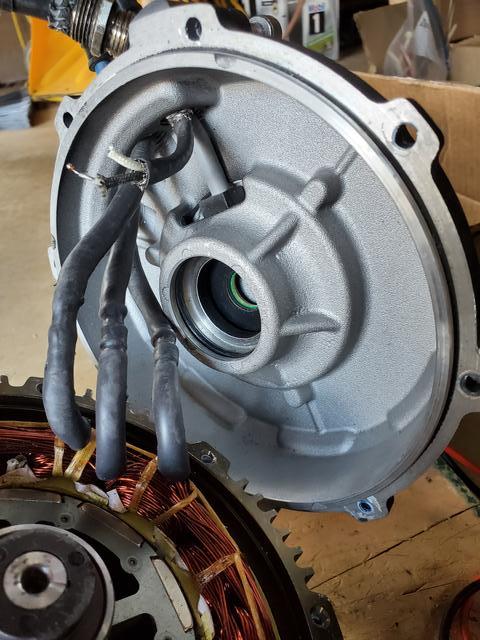
Where I'm putting my temp sensor, you can see the old cloth insulated wire where the old temp sensor was. I learned to use this method of installing a temp sensor from Alex doing it on a hub motor bike. I'm not really sure if this is the best way or if there is a better way, or how quickly the temp sensor will read the correct temps inside the thermal paste.

Filled the space with thermal paste,
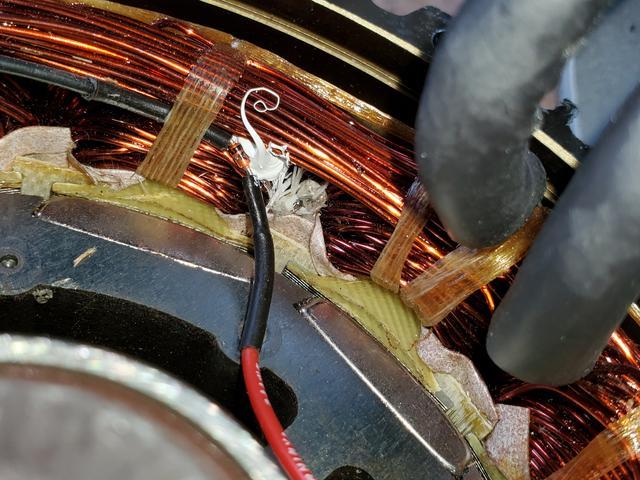
Pushed the temp probe inside the termal paste

Covered the thermal paste with silicone to hold everything together.

The halls and temp probe connector. The black and white cloth wires are for the temp sensor. The Black cloth wire is also connected to the halls negative wire on the same pin. The KTY84 sensor does have polarity and the black is connected to the negative side of the KTY 84.
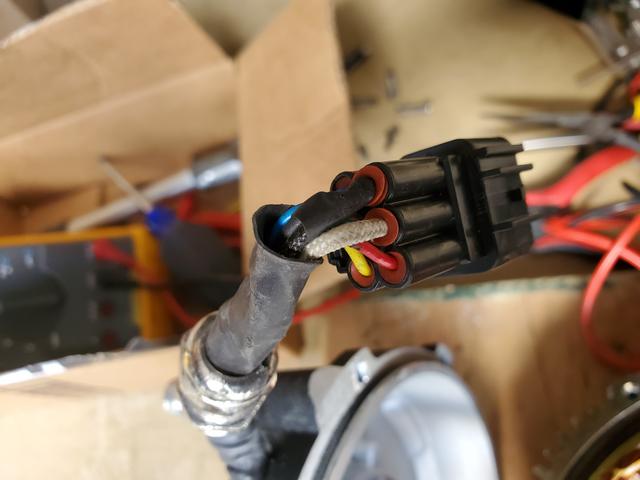
I'm finally installing a new KTY 84 temp probe in my motor as I'm a bit paranoid about the temps, especially using my nuclear controller and hot 100F summer temps. I will also install my DC/DC converter for my LED lights.
This is a bitch of a job let me tell you, installing a temp sensor in a motor is probably the worst of the jobs you can do on a bike.
I'm crossing my fingers that this thing works when I put everything back
Some pics:

Getting these connectors off the bike was a real bitch, you can't get a wrench around them so you have to take your time. Then you have to deal with annoying rubber and plastic inserts. Words can't describe how annoying this was and then I have to put all of this back.


These gray plastic insert did not just lift up, you have to pry each of those plastic pieces up then lift it up.

I circled in black where the old temp sensor wires connected to, the original KTY84 temp sensor broke in half at the sensor itself and pulled right out of here, I had to cut the other wire. There is no getting to this area to put the temp sensor back. Just my crap luck that my sensor broke. There is no way to know how common an issue this is because unless you get another controller you will not know if your temp sensor works. I may be the only motor which had the sensor break with my luck

The black wire has part of the original KTY84 sensor still attached where it broke off. You can see the halls gray wire just behind it connected to what looks like a circuit board in the center of the case cover.

Where I'm putting my temp sensor, you can see the old cloth insulated wire where the old temp sensor was. I learned to use this method of installing a temp sensor from Alex doing it on a hub motor bike. I'm not really sure if this is the best way or if there is a better way, or how quickly the temp sensor will read the correct temps inside the thermal paste.

Filled the space with thermal paste,

Pushed the temp probe inside the termal paste

Covered the thermal paste with silicone to hold everything together.

The halls and temp probe connector. The black and white cloth wires are for the temp sensor. The Black cloth wire is also connected to the halls negative wire on the same pin. The KTY84 sensor does have polarity and the black is connected to the negative side of the KTY 84.

Tommm said:Better to use heat sink plaster. A thermal paste with adhesive properties.
I did think about that when applying it, would I be better with something like a thermal epoxy or thermal adhesive. Maybe, it would make it quicker to install. Then I thought about it and thought, the way I did it makes it completely removable. Not that that really matters. I also didn't have any thermal epoxy and didn't want to wait.
There is also an issue with thermal epoxy: It may not hold up to constant temperature cycling as seen in an Ebike motor. I had a cromotor with a temp sensor that was epoxied from the factory, when I opened the motor up the epoxy just flaked off. If you did use a thermal adhesive or epoxy it may break down with time and you will either have an air gap or have the thing fail and fall off the windings.
It probably doesn't matter which way you do it.
Here is something I found on google:
Effects of thermal cycling on epoxy bonded materials
Thermal cycling is a concern to those who use epoxy as an adhesion in space applications due to the mechanical and thermal properties of both the epoxy and adhered materials. These properties include the thermal expansion coefficient, a, and the stress at which the epoxy will yield fracture. An experiment was carried out to find out if failure would occur by thermal cycling of epoxy bonded components in the propulsion components of a small satellite. Failure did not occur due to shear stress attributed to the thermal expansion coefficient but unexpectedly to the liquefaction of epoxy in 3 of the 6 samples. The samples with thicker epoxy layers failed in contrast to the thinner epoxy layer samples. Overall, thermal cycling is still a concern for failure of the epoxy bond.
Offroader said:I did think about that when applying it, would I be better with something like a thermal epoxy or thermal adhesive. Maybe, it would make it quicker to install. Then I thought about it and thought, the way I did it makes it completely removable. Not that that really matters. I also didn't have any thermal epoxy and didn't want to wait.
The thermal epoxy I have dries and rubberises after being applied, so it is normal for it to be dry and flaky if you tear the two parts apart that it was holding, I can remove it with my fingernails. You can bet they didn't use the top shelf stuff in either products. :lol:
That said, since your motor doesn't have forced air cooling it doesn't really change anything since the winding of the copper is a better heat conductor than the trapped hot air surrounding it, with or without the glue.
Thermal expansion is a big factor when choosing a motor/battery potting compound, they are specialised to expand a set amount to fit the application. Mind you, in space going into extreme negatives is routine, so liquids tuning solids and vice versa along with evaporation are additional concerns.
However, the typical range of temperatures was found to be from -170 ˚C to 123 ˚C for LEO satellites while -250 ˚C(-420F) to 300 ˚C(570F) could be experienced in other orbits.
Your silicone is the way to go. You won't have problems with that.
With my bike motor, I found that by placing the sensor directly in contact with the copper windings, the temperature readings were pretty darn high at times. You really just want to keep the hall sensors below 150C and the magnets below about 100C. The copper itself can handle more depending on the type of insulation. If you see the temps going sky high very quickly, don't be too alarmed.
How much power are you getting with your Nuclear setup?
With my bike motor, I found that by placing the sensor directly in contact with the copper windings, the temperature readings were pretty darn high at times. You really just want to keep the hall sensors below 150C and the magnets below about 100C. The copper itself can handle more depending on the type of insulation. If you see the temps going sky high very quickly, don't be too alarmed.
How much power are you getting with your Nuclear setup?
The thing that worries me is even though the nuclear controller is only pushing 90 amps X battery stock voltage, the controller seems to have more field weakening, which is notorious for overheating motors.
The controller also seems to be more aggressive with how it sends power to the motor which means its going to heat up quicker. I also always have the controller at full throttle, and full throttle on the street using max field weakening, then I'll do something like climb 6 long flights of stairs, I really punish these motors and heat them up.
The motor is burning hot to the touch, especially with these 100F days and I really like to ride mostly on hot days. I found that hot 90F+ days is very hard on the motors and they can not cool effectively. This burning hot to the touch may mean nothing when the windings are on the outside of the motor, when compared to a burning hot hubmotor which has the magnets on the outside of the motor.
I'll have to see just how hot things are getting once I get this temp sensor installed. Then the other question is, if the winding go as hot as 150C, is that my temp limit, or with a motor like the sur-ron which has the windings on the outside of the motor mean I could probably go higher temp in the windings?
The controller also seems to be more aggressive with how it sends power to the motor which means its going to heat up quicker. I also always have the controller at full throttle, and full throttle on the street using max field weakening, then I'll do something like climb 6 long flights of stairs, I really punish these motors and heat them up.
The motor is burning hot to the touch, especially with these 100F days and I really like to ride mostly on hot days. I found that hot 90F+ days is very hard on the motors and they can not cool effectively. This burning hot to the touch may mean nothing when the windings are on the outside of the motor, when compared to a burning hot hubmotor which has the magnets on the outside of the motor.
I'll have to see just how hot things are getting once I get this temp sensor installed. Then the other question is, if the winding go as hot as 150C, is that my temp limit, or with a motor like the sur-ron which has the windings on the outside of the motor mean I could probably go higher temp in the windings?
The max winding temp will depend on what insulation class they used. Class H is the highest but I doubt they used that stuff. Class H can go up to 220C continuous. My guess is the insulation is good for at least 150C and maybe 180C. You can go over the rating for short time periods (up to a point).
The hall sensors are likely rated for 150C but they are going to be quite a bit cooler than the copper. The magnets will fail at some temp too, but we don't know what grade the magnets are. They will be good for at least 80C but more likely 100C.
On my A2B, the windings get really really hot and the outside is barely hot so there's a big gradient between the copper and the outside housing. My temp sensor is not really calibrated on that one but I'm sure I've run it over 150C and had no issues. The copper heats up much faster than the rest of the motor.
It will be interesting to see what kind of numbers you get. I wouldn't be surprised if you get it up to 200C with your "normal" riding.
The hall sensors are likely rated for 150C but they are going to be quite a bit cooler than the copper. The magnets will fail at some temp too, but we don't know what grade the magnets are. They will be good for at least 80C but more likely 100C.
On my A2B, the windings get really really hot and the outside is barely hot so there's a big gradient between the copper and the outside housing. My temp sensor is not really calibrated on that one but I'm sure I've run it over 150C and had no issues. The copper heats up much faster than the rest of the motor.
It will be interesting to see what kind of numbers you get. I wouldn't be surprised if you get it up to 200C with your "normal" riding.
Hummina Shadeeba
1 MW
https://essexwire.com/products/endurotemp-260/
Highest temp stuff I’ve seen
Highest temp stuff I’ve seen
Hummina Shadeeba said:https://essexwire.com/products/endurotemp-260/
Highest temp stuff I’ve seen
For sure Sur-ron won't be using that. Great choice if you fry a motor and want to rewind it.
Hummina Shadeeba
1 MW
But u have to buy forty pounds.
Having difficulty with the belt tension when putting the motor back. First, I'm not sure what it should feel like so that doesn't help anything. I forgot to check the tension before I removed the motor :x .
The other issue is its hard to make fine adjustments to the belt tension because you have to move the whole motor. The issue is I seem to get it too stiff or too loose. Part of the reason may be because of this rotation limiter or what ever it is that has notches on it as shown in the picture. These notches may not allow me to fine tune the tension enough.
I'm wondering if its better to go a little tight or a little loose. The belt is also so small that I'm not even sure if maybe I shouldn't have that much deflection in the belt when pushing on it.
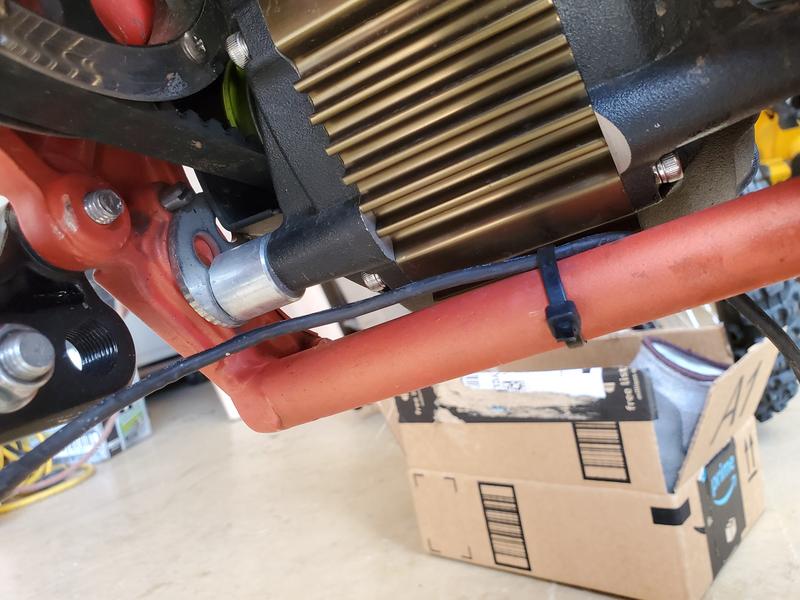
The other issue is its hard to make fine adjustments to the belt tension because you have to move the whole motor. The issue is I seem to get it too stiff or too loose. Part of the reason may be because of this rotation limiter or what ever it is that has notches on it as shown in the picture. These notches may not allow me to fine tune the tension enough.
I'm wondering if its better to go a little tight or a little loose. The belt is also so small that I'm not even sure if maybe I shouldn't have that much deflection in the belt when pushing on it.

The primary belt needs to be pretty darn tight. I used a piece of wood as a pry bar to tension the belt while moving the eccentric cam in to place. I don't think you can get it tight enough without a pry bar. Of course you don't want it too tight either, but we don't have a good way to measure the tension. You should see some deflection if you press on the belt, but not much.
The Sur-ron motor is not potted.
The Sur-ron motor is not potted.
You used a pry bar to add more tension then the tension caused by the weight of the motor? If you loosen all the bolts the motor will fall down and that I find is too much tension.
Did you use anti seize on any of the bolts going into the motor? The bolts are steel going into the aluminum motor.
Did you use anti seize on any of the bolts going into the motor? The bolts are steel going into the aluminum motor.
thoroughbred
100 W
What size are the phase wires into the motor, are they 8G?
Finally rode my bike with the new KTY 84 temp probe.
Highest I could get the motor was 72C-74C. It mostly stayed around 65C-70C. This is with 88F outside air. This is also using 90 amps x battery voltage with a Nuclear 24 fet controller.
I checked the case temp with an infared thermometer, when the temp was 65C inside the motor measured by the temp probe, the case temp measured 57C.
Temperatures also do not spike quickly, even at full throttle and hill climbing.
Does anyone think these numbers are kind of too low? Even the motor case temp outside was 57C and only 8C cooler than inside at the windings?
Highest I could get the motor was 72C-74C. It mostly stayed around 65C-70C. This is with 88F outside air. This is also using 90 amps x battery voltage with a Nuclear 24 fet controller.
I checked the case temp with an infared thermometer, when the temp was 65C inside the motor measured by the temp probe, the case temp measured 57C.
Temperatures also do not spike quickly, even at full throttle and hill climbing.
Does anyone think these numbers are kind of too low? Even the motor case temp outside was 57C and only 8C cooler than inside at the windings?
That sounds excellent. You should be able to check the accuracy of the temp probe by comparing inside and outside when the motor hasn't been run for a long time and they should be the same.
Great news that the winding temp is only slightly higher than the case. It's all metal in contact, so should not be too surprising.
Thanks for posting the test results.
Great news that the winding temp is only slightly higher than the case. It's all metal in contact, so should not be too surprising.
Thanks for posting the test results.
sn0wchyld
100 kW
Offroader said:Finally rode my bike with the new KTY 84 temp probe.
Highest I could get the motor was 72C-74C. It mostly stayed around 65C-70C. This is with 88F outside air. This is also using 90 amps x battery voltage with a Nuclear 24 fet controller.
I checked the case temp with an infared thermometer, when the temp was 65C inside the motor measured by the temp probe, the case temp measured 57C.
Temperatures also do not spike quickly, even at full throttle and hill climbing.
Does anyone think these numbers are kind of too low? Even the motor case temp outside was 57C and only 8C cooler than inside at the windings?
About what I'm seeing, with stock battery and temp probe (24f nuk too). I find higher speeds heats the motor faster, but then I've also got ~100A of field weakening on. This is using 120A peaks from stock battery (hammering it a bit yes) and 450phA. No issues with heat at lower speeds 'trials' type fooling around, at ambient around 20C I'll eventually get to 70C. Not sure I've ever hit 80 yet, but I tend to ride 'slower' more technical stuff. That said same riding with my mxus 3k and it'll be at 140 in no time, with less torque output (330phA/8kw input).
This is good that the motor keeps such low temps. This means you can safely up the power to probably around 8KW maybe more and still be able to ride the bike as hard as you can in 100F ambient temps without worry of overheating.
You could also run the bike with overdrive on the highway for a long time without overheating, the wind will really help to cool the motor which sucks up the heat quickly from the windings. I remember with hub motors the surface would be very hot if you let the bike sit for a minute, but as soon as you started riding it would be cool to the touch because the heat took too long to get to the outside surface of the motor. The Sur-Ron motor pretty much stays very hot the entire time when riding.
This is pretty amazing, especially coming from hub motors which had non-stop issues with overheating.
You could also run the bike with overdrive on the highway for a long time without overheating, the wind will really help to cool the motor which sucks up the heat quickly from the windings. I remember with hub motors the surface would be very hot if you let the bike sit for a minute, but as soon as you started riding it would be cool to the touch because the heat took too long to get to the outside surface of the motor. The Sur-Ron motor pretty much stays very hot the entire time when riding.
This is pretty amazing, especially coming from hub motors which had non-stop issues with overheating.
Similar threads
- Replies
- 3
- Views
- 1,020
- Replies
- 15
- Views
- 5,210
- Replies
- 2
- Views
- 717
- Replies
- 27
- Views
- 4,181


